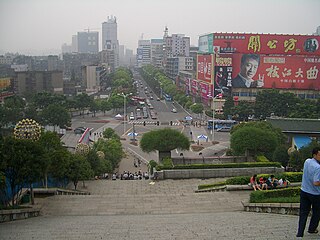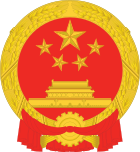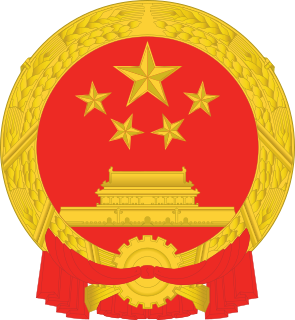
Jilin is one of the three provinces of Northeast China. Jilin borders North Korea and Russia to the east, Heilongjiang to the north, Liaoning to the south, and Inner Mongolia to the west.

Provincial-level administrative divisions, or first-level administrative divisions, are the highest-level Chinese administrative divisions. There are 34 such divisions, classified as 23 provinces, four municipalities, five autonomous regions, and two Special Administrative Regions. All but Taiwan Province and a small fraction of Fujian Province are controlled by the People's Republic of China.

Shishou is a county-level city under the administration of the prefectural-level city Jingzhou, in the south of Hubei province, near its border with Hunan province, and is located in the middle reaches of the Yangtze River. The Swan Islet Wetland of the Yangtze River in this area is the world’s largest national natural reserve both for wild elks(Milu, or David Deer) and for Chinese river dolphins. The Shishou City National Baiji Reserve for Chinese river dolphins is nearby. It shares its name with a stream flowing into the Yangtze River. In addition, the area enjoys convenient transportation, with an hour’s drive from Yueyang East Railway Station on the Beijing-Guangzhou high-speed railway line, and 70 kilometers from Jingzhou Railway Station on the Shanghai-Wuhan-Chengdu high-speed railway line. Moreover, Shishou boasts a diversified landscape, including mountains, hills, lakes, rivers, terraces and plains, as well as abundant resources such as rice, cotton, oil plants, eggs, fish, and lotus roots.

Revitalize The Old Northeast Industrial Bases, also Revitalize Northeast China or Northeast China Revitalization, is a policy adopted by the People's Republic of China to rejuvenate industrial bases in Northeast China. The areas targeted once functioned as the center of heavy industry in China, first under Japanese-occupation and then under the state-led development of the People's Republic of China. Since the 1980s, the region has been heavily affected by the restructuring of the Chinese economy and the closing and consolidation of many heavy industry State-owned enterprises (SOEs). It covers three provinces: Heilongjiang, Jilin, and Liaoning, collectively referred to as Dongbei, as well as the five eastern prefectures of Inner Mongolia: Xilin Gol, Chifeng, Tongliao, Hinggan and Hulunbuir.

Huarong County is a county in Hunan province, China, it is under the administration of Yueyang City.

Yingcheng is a sub-prefecture-level city of about 600,000 inhabitants in eastern Hubei province, People's Republic of China.
The first libraries in China came into being during the time of the Shang dynasty as intellectuals known as the Shi (historians) and Wu (diviners) emerged from manual labor to special occupations for the creation and spread of culture. Among the documents that these occupations managed were "the country's statute books, genealogies of imperial kinsmen, issued notices and orders, and recorded important events and natural phenomena. For future verification and reference, they built storehouses to keep records in different media. To meet the needs of more and more complicated affairs and to ensure easy use, they began to collect and sort out those records according to chronological order and category. Thus, the earliest library in China came into being. The numerous kinds of media loaded with information and knowledge emerged in human society, resulting in the concepts of preservation and collection. Accordingly, the earliest libraries and archives were the result of conscious collection, process, coalition, and utilization."

Xiling is a district of Yichang, Hubei, People's Republic of China. It includes the central part of Yichang's urban area, on the left (northwestern) bank of the Yangtze River.

The China–Japan–South Korea trilateral summit is an annual summit held between China, Japan and South Korea, three major countries in East Asia. The first summit was held during December 2008 in Fukuoka, Japan. The talks are focused on maintaining strong trilateral relations, the regional economy and disaster relief.

Xinhua District is a district of Shijiazhuang, the capital of Hebei province, People's Republic of China.

Kaifu District is one of six urban districts of Changsha, the capital of Hunan province, China. The district is bordered by Furong and Tianxin Districts to the south, Changsha County to the east and northeast, Wangcheng District to the north, Yuelu and Wangcheng Districts across the Xiang river to the west. Located in the central Changsha, Kaifu covers 188.73 km2 (72.87 sq mi) with population of 595,000, registered population of 452,168. The district has 16 subdistricts under its jurisdiction, the government seat is at Furongbeilu subdistrict.

Beihu District is one of two urban districts in Chenzhou Prefecture-level City, Hunan province, China.

Luhe District is one of 11 districts of Nanjing, the capital of Jiangsu province, China.

Yuhong District is one of nine districts of Shenyang, the capital of Liaoning province, People's Republic of China, and forms part of the northwestern and western suburbs. It borders Shenbei New Area to the northeast, Huanggu District to the east, Sujiatun District to the south, and Xinmin City to the west; in addition, Tiexi District also lies in between the two parts of Yuhong.

Lingyuan is a city in the west of Liaoning province in Northeast China, bordering Hebei province and Inner Mongolia. It is under the administration of Chaoyang City, which lies 94 kilometres (58 mi) to the east-northeast.

Yongding District is one of two urban districts in Zhangjiajie City, Hunan Province, China. Located on the south of Zhangjiajie, the district is bordered to the north by Wulingyuan District and Sangzhi County, to the northeast by Cili County, to the east by Taoyuan County, to the southeast by Yuanling County, to the southwest by Yongshun County. Yongding District has an area of 2,208 kilometres (1,372 mi) with 468,300 of registered population. It is divided into 6 subdistricts, 7 towns and 7 subdistricts, its government seat is Xixiping (西溪坪街道).

Tianjin Free-Trade Zone, officially China (Tianjin) Pilot Free-Trade Zone is a free-trade zone in Tianjin, China. It is the only free-trade zone in North China. The zone covers three areas — Tianjin Airport Economic Area, Dongjiang Free Trade Port Zone and Binhai New Area Central Business District.

The Guangdong-Hong Kong-Macau Greater Bay Area, Guangdong-Hong Kong-Macao Greater Bay Area or simply Greater Bay Area (GBA), is a megalopolis formerly known as the Pearl River Delta consisting of 9 cities and 2 special administrative regions in south China. On 7 December 2016, the concept of the area was mentioned in the English version of the 13th Five-Year Plan for Economic and Social Development of the People’s Republic of China. On 13 April 2017, the heading of a piece of news released at the English.gov.cn website of the State Council adopted the name "Guangdong-Hong Kong-Macao Bay Area". After a few months, on 1 July 2017, the "Framework Agreement on Deepening Guangdong - Hong Kong - Macao Cooperation in the Development of the Bay Area" was signed in Hong Kong.





















